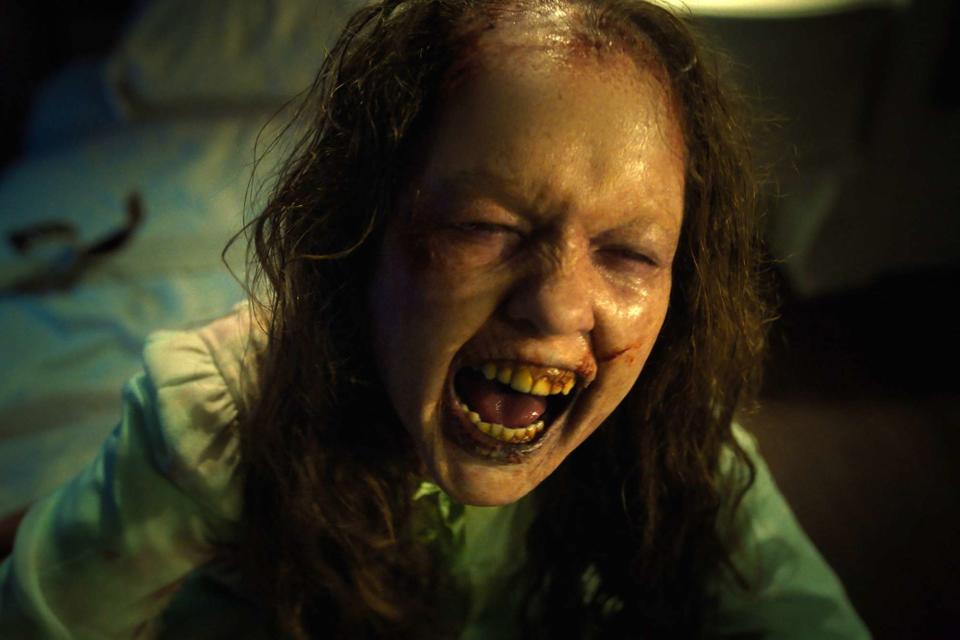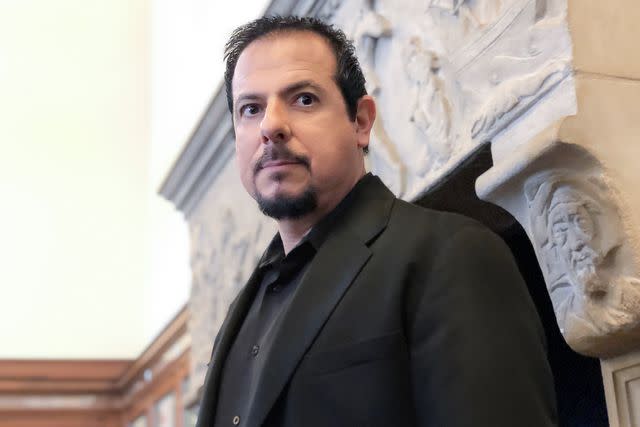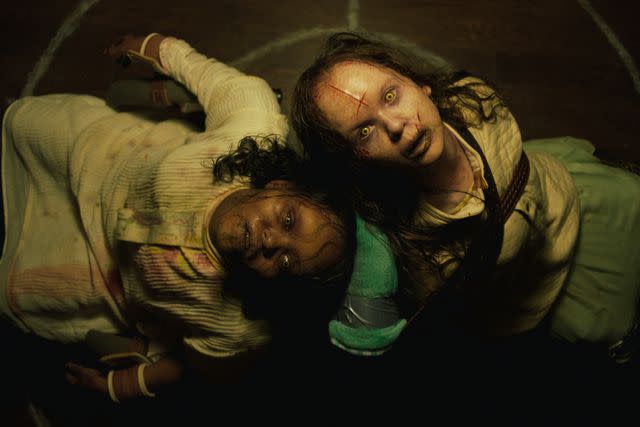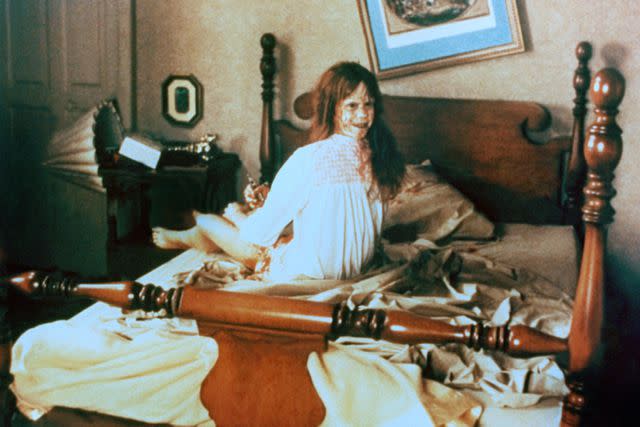Yes, “The Exorcist: Believer” Is Based on Real-Life Possession Stories: Expert (Exclusive)
- Oops!Something went wrong.Please try again later.
Technical advisor and creative consultant Christopher Chacon works to “enhance the authenticity” of Hollywood’s eeriest productions — using firsthand experience

Universal Pictures/Everett
Olivia O'Neill in "The Exorcist: Believer"It may defy belief that The Exorcist: Believer is based on real events — but according to its technical advisor and creative consultant, audiences should cast out their doubts.
“These are real phenomena,” claims Christopher Chacon, an expert who consults on both real-world possession cases and Hollywood’s screen adaptations of such. “All the elements we put in The Exorcist: Believer are very authentic and [based on] these experiences that people have encountered.”
And those experiences aren’t second-hand. Chacon himself has seen disturbing human behavior around the globe that remains — given the rigorous process of elimination he applies to each case — unexplainable. “I've seen it demonstrated and take place in real life,” he tells PEOPLE exclusively. “Not only that, but we're able to scientifically assess it and analyze it. And even with state-of-the-art technology, you still have no answers because you're dealing with something that science can't measure in every way.”
Extreme examples include “objects flying around the room, magnetic fields that are fluctuating hugely, temperatures changing by 70 to 80 degrees,” per Chacon, 59. “There are cases where there's electrical arcing manifesting; if it hits you, it's like being zapped.”

Courtesy of CEM
Christopher ChaconHow did the California-born Chacon begin investigating not just reported possessions, but “hauntings and poltergeists, strange creature sightings or attacks, UFO close encounters, black magic, all kinds of phenomena which cannot be explained rationally,” as he says? While paying his way through college as a magician and illusionist, he received an invitation to investigate an allegedly haunted house. Although “a little bit more cynical” at the time, the then-amateur anomalist remembers being “really intrigued by” both the phenomena and their effects on those experiencing them.
The most accurate terminology to describe all the above is “preternatural phenomena,” he says, adding, “It's not supernatural. It's just that we don't understand these phenomena.”
After meeting and collaborating with parapsychologists Russell Targ, Scott Rogo and Loyd Auerbach, Chacon joined the "anomalistics division" of a Silicon Valley scientific think tank studying “everything from astrophysics to zoology,” he says.
Once he began appearing as an expert commentator on investigative shows, like Sightings, Unsolved Mysteries and Scariest Places on Earth, Hollywood came calling. Chacon was co-creator and showrunner of 1990s scripted Canadian series, PSI Factor: Chronicles of the Paranormal, hosted by Dan Aykroyd, and has since consulted on the Paranormal Activity franchise, 2015’s Poltergeist, The In Between and more.
“Sometimes it’s from the ground up as the writers are structuring it, sometimes it's way into production and they're tweaking things,” he says of his film and TV consulting. “Sometimes it's how a phenomena acts, what I refer to as the phenomenology, how things react in the environment — how do people react? [Filmmakers] might ask about an occult object, how it might look on set.”
On The Exorcist: Believer, for example, Chacon helped director and cowriter David Gordon Green “find a cohesiveness for the vision of it.” He adds, “I'm giving them whatever I can to enhance the authenticity.”
Related: Maryland Man Wins $40K Lottery Prize After Psychic Told Him His Late Father Wanted Him to Play

Universal Pictures
(Left to right:) Lidya Jewett and Olivia O'Neill in "The Exorcist: Believer"Investigating cases offscreen, however, requires providing a different — and “very unbiased” — kind of perspective. “There are thousands and thousands of cases being reported,” according to Chacon. “The only ones that get forwarded to me is when the phenomena is extreme. They are at their wit's end in how to define it.”
Before he agrees to travel to check the phenomena himself, Chacon says the individuals or institutions contacting him must “rule out explainable phenomenon: psychological elements, physiological, environmental, and of course, hoaxes. They have to do background checks on the people involved.”
For occult-related cases, “70 to 80 percent have a rational explanation.” Misperceptions abound, he adds, especially among “religious groups [who] have a tendency to see things black and white when something might look malevolent.” Part of traveling the globe to approach each investigation with a scientific method means remembering that “every area has their own culture and belief system” that may affect their interpretation of different phenomena.
For confidentiality reasons, Chacon can’t divulge to PEOPLE the details of that remaining 20 to 30 percent. But his most extreme cases, he reports, involved a man assumed to be possessed clawing at his own flesh — “a creature trying to escape this vessel,” he says — and a convulsing man who died, only to have a young nephew nearby start to exhibit the same symptoms, “as if this thing jumped from one person to another.”
Fans of 1973’s The Exorcist and its follow-ups will no doubt recognize such stranger-than-fiction details. As Chacon points out, the box office success of that Oscar-winning film comes from its “very grounded” approach to the unexplainable events it depicts “almost as a documentary.”
“All the phenomena, the ritual, how people react, it’s all accurate, the way it really is,” he continues. The Exorcist: Believer takes the same approach, although, he acknowledges, “the phenomenon is much more disturbing than the original one.”
Yet, as Chacon notes, “They did an incredible job of recreating that, putting that chemistry together, of creating that feeling of being grounded. It gets under your skin emotionally.”
Never miss a story — sign up for PEOPLE's free daily newsletter to stay up-to-date on the best of what PEOPLE has to offer, from juicy celebrity news to compelling human interest stories.

Warner Bros./Everett
Linda Blair in 1973's "The Exorcist"Related: Celebs Who Have Had Actual Ghost Encounters
According to Chacon, belief in unexplainable phenomena is on the rise. “There's a growing percentage of people who said they saw an exorcism or saw someone who was possessed,” he claims.
A 2005 Gallup survey concluded that “three in four Americans profess at least one paranormal belief,” with 41% believing in extrasensory perception. A 2021 study conducted by OnePoll found that 57% of Americans over age 21 believe in ghosts (while 39% believe in extraterrestrial visitors and 27% believe in Bigfoot).
It explains why each Halloween audiences flock to theaters for, as Chacon says, the “chemical rush that happens in the safety of our seats.” There’s an additional satisfaction, he adds, in knowing what’s on screen is just pretend — unless, of course, it’s convincing enough to make a believer out of them.
When asked whether the phenomena depicted in an Exorcist movie is authentic, he struggles to answer because Hollywood magic is “all fantasy.” Chacon says, “It's really hard for someone to grasp the idea that that [on screen is] real. That can actually happen, that kind of phenomena. It's not supposed to happen in real life.”
For more People news, make sure to sign up for our newsletter!
Read the original article on People.

